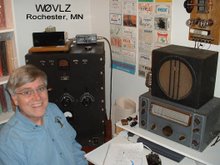


I have a working 815 transmitter. Unfortunately I had to "glue" a capacitor on to the side of the chassis to do it. Key to getting the final to work into a variety of loads is some sort of antenna tuner. Adding a capacitor into the grounded side of the output link does just that. The added capacitor does output loading . Tune up now amounts dipping the final with C2 and increasing/decreasing the loading with the added output link capacitor. Typical operation is 50 watts input and 35 watts out.
Eventually the loading capacitor will be hidden behind a front panel.










